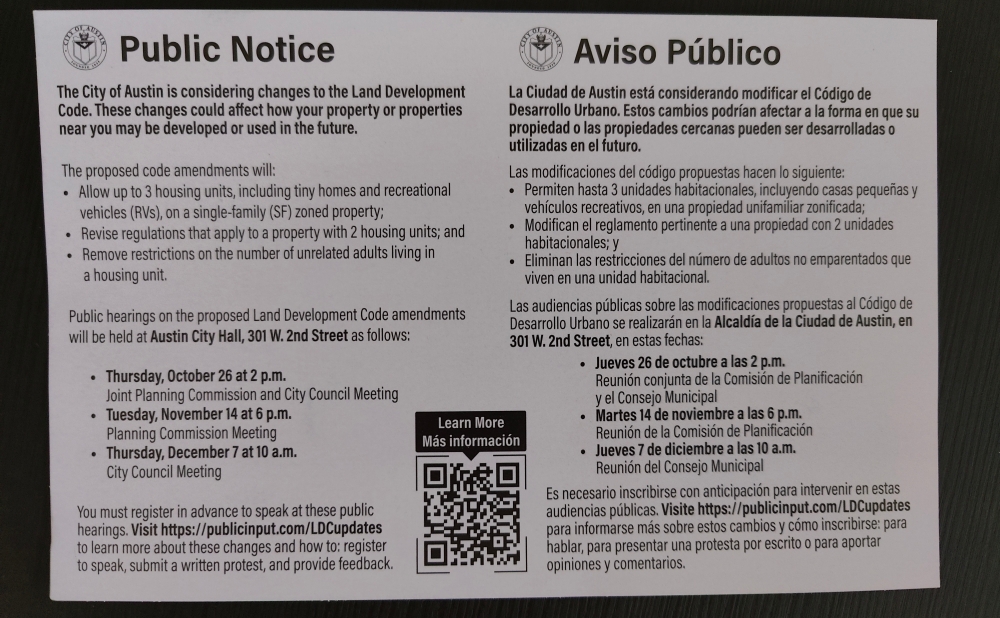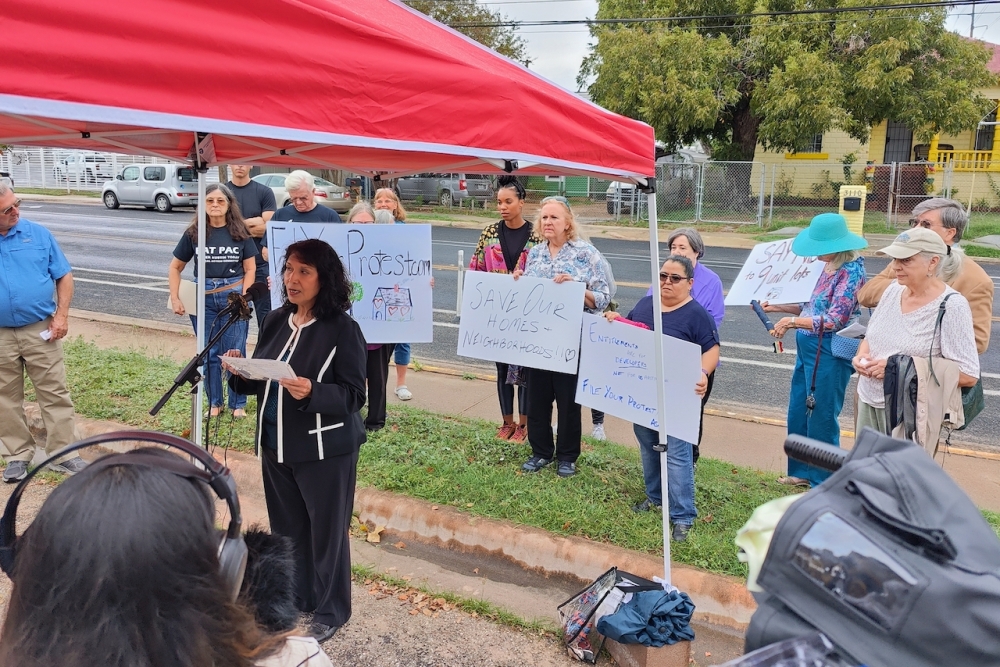How we got here
At the center of the hearing and related public debate is a piece of the HOME, or Home Options for Middle-income Empowerment, initiative drafted by council member Leslie Pool earlier this year.
In July, council passed Pool's resolution to both increase the number of housing units allowed on many single-family properties to three, and to reduce the amount of land required to build residential housing by about 50%.
Council could advance the unit cap increase before the end of the year, while officials plan to tackle minimum lot size separately in early 2024.Since introducing HOME, Pool has said she hopes the changes can allow for gradual density increases in a growing city that's seen housing prices increasingly put homeownership out of reach for families and middle-income earners.
"I join those who feel alarmed about what’s happening in our neighborhoods—big, new homes sprouting up at eye-popping prices and sizes sending outward cues confirming the aching worry keeping us up at night: we don’t belong here anymore," Pool said in an October newsletter. "Certainly, there is no housing crisis for those who can afford to buy where and what they want. That’s not the vast majority of Austinites. I think we can all agree that the status quo is not working especially well for the middle-class."
Upcoming action could also adjust a handful of regulations for two-unit projects and allow more people to live together in the same space.What's happening
The Oct. 26 public hearing will be the first ever involving both City Council and the resident Planning Commission.

- Mailing more than 725,000 individual notices to city residents in October
- Publishing an $1,100 newspaper notice
- Setting up a public input website
- Promoting the hearing on social media
According to opponents
Council's attempts to revise housing and development policies have once again proven controversial, with opinions on both sides of the current debate over the HOME proposal echoing similar sentiments shared throughout past attempts to overhaul land development rules.
Opponents have expressed fears about damaging the long-established characteristics of their communities, including the many single-family-heavy neighborhoods that surround the urban core, via change that many longtime residents don't support.
“For most families, buying a home is the most major investment they’ll ever make. It is the method by which we have generational wealth passed down," attorney Bill Aleshire said during an Oct. 25 rally. "Homeowners and families should not have to fight the government to protect their investment or the neighborhood lifestyle that they have chosen.

Other groups, including the Austin Neighborhoods Council, Community Not Commodity and Go Austin/Vamos Austin, have asked council to slow down HOME's review to address resident pushback. Concerns raised include the potential for rising property taxes and negative environmental impacts.
“This is not a planning proposal; this is an ideology proposal of developer deregulations—neoliberal, Reagan supply-side economics that doesn’t work," Bunch said. "It won’t make housing more affordable. It won’t protect the climate or the environment. And what it is is forcing zoning change on homeowners, thousands and thousands of homeowners."
For GAVA Executive Director Carmen Llanes, HOME carries the threat of heightened development pressures that could further gentrification in areas already experiencing its effects, particularly around East Austin.
"The victims of these policies are the people who don’t have the resources to legally enforce their rights. They are the losers in the market, and these policies have not been created with low-income homeowners or renters or unhoused people in mind," she said. "If they were, then they wouldn’t be deregulating and offering our land up to developers and investors while disregarding safety regulations."
Llanes said council should scrap its HOME push and instead consider less sweeping work on cheaper housing, such as accessory dwelling units, or ADUs. She and others have also asked city officials to revisit the "People's Plan" for Austin housing policy proposed by community leaders in the 2010s.
According to supporters
Many in favor of HOME say the city continues to confront a crisis of affordability and displacement among the working and middle class that can be addressed through land-use reforms.
Groups including AARP Texas, local housing advocacy organizations, and real estate and development representatives have all thrown their support behind the proposal.
In their view, key fixes include updating an archaic civic land development code and unlocking more land for slightly denser residential options that have traditionally been blocked. They’ve also pointed to the code encouraging sprawl and construction aimed at wealthier homebuyers, while disincentivizing options for more attainable homeownership or flexible development.
"To be able to have the opportunity to buy a home, as many Austinites did in the past, that door has been closed," said Scott Turner, founder of custom developer Riverside Homes and real estate firm Turner Residential. "If council wants to give people that chance, they’re going to have to make changes like this. Because our current system is the problem.”
Turner also said that some of the negative outcomes anticipated by HOME opponents, such as gentrification and rising home values, have been widespread under the city's longstanding regulations.
Looking at current home sales values across the city, Turner is already seeing the rare duplexes or ADUs selling well below the price point of single-family homes located in the same neighborhood. And for him, the pervasive home teardowns that only produce larger and more expensive new construction have already become the norm.
“I understand the concern about, ‘Hey nothing is affordable.’ But unless you make a change like this, why would it ever be affordable again if we’re stuck building big single-family homes because that’s what the code says we should do?” he said.Jake Wegmann, an associate professor at The University of Texas specializing in housing and land-use issues, said he stands behind HOME and pushed back what he called fear-mongering about its potential for rapid and unwanted change.
Wegmann said he's already seen a wave of high-value redevelopment that may have turned out differently if options like triplexes or ADUs were previously permitted. He also said what will likely be gradual change is needed to modernize Austin, and noted that no changes are being forced on property owners.
“Our neighborhoods are already changing. Where I live in Crestview, there have been dozens of houses since I’ve lived there that have been torn down and replaced, and they’ve mostly been replaced with very expensive single-family houses, or at most two units on the same property," he said. "We have neighborhood change under the status quo. There’s no policy that the city of Austin can adopt that can prevent someone from selling their house to someone who’s going to pay a lot of money for it.”
Diving in deeper
Attempts like Austin's to roll out widespread changes in single-family zoning are uncommon, but outcomes in a few other cities offer some points of comparison.
Wegmann pointed to Houston and its wide open zoning landscape as one example where similar changes proved fruitful. His research into its "townhouse boom" made possible by land-use decisions over previous decades found those reforms were generally well-received and resulted in the creation of more housing options in more places. The updates resulted in "relatively modest" change rather than an overnight transformation, he said, and may also have helped slow gentrification effects. Recent research on Houston's policies from UT also found that the city's lowering of lot sizes had positive effects on affordability without spurring displacement.
“It certainly hasn’t magically ended the shortage of housing affordable to very low-income people in Houston, but it certainly has expanded the range of options for middle-income, aspiring homeowners," he said.
To the north, Portland's government recently shared a look at the early effects of the city's "Residential Infill Project," or RIP.
That policy's adjustments to residential building rules aimed at "middle housing" found that it encouraged that type of construction, nearly tripling the amount of more efficient housing for families or first-time homebuyers permitted in the year after RIP's passage. That housing also took up fewer lots and was located closer to city activity centers.
An Urban Studies report published earlier this year looked into several cities' approaches on zoning to see how changes might affect affordability. That study's authors concluded that while zoning reform often leads to an increase in added housing, such changes often don't make it any easier for low- or middle-income earners to find a place to live.





